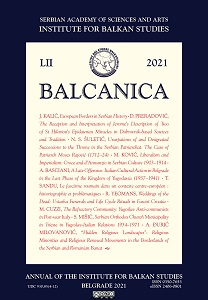The Reception and Interpretation of St. Jerome's Description of Two of St Hilarion's Epidaurian Miracles in Dubrovnik-based Sources and Tradition
The Reception and Interpretation of St. Jerome's Description of Two of St Hilarion's Epidaurian Miracles in Dubrovnik-based Sources and Tradition
Author(s): Dubravka PreradovićSubject(s): History, Theology and Religion
Published by: Balkanološki institut - Srpska akademija nauka i umetnosti
Keywords: St Jerome; the miracles of St Hilarion; saintly dragon-slayer; Epidaurus; Dubrovnik; Cadmus; Asclepius; written sources; the cult of St Hilarion
Summary/Abstract: Abstract: The brief sojourn of St Hilarion to a setting not far from Epidaurus in Dalmatia in circa 365 CE was depicted by St Jerome in Vita Sancti Hilarionis, portraying the two notable miracles of the famous Palestinian anchorite - the slaying of the dragon Boas ravaging the area and the rescue of the city from the giant waves that threatened to devastate it. Both miracles have been interwoven into the later narratives of both medieval writers and the Renaissance chroniclers of Dubrovnik, especially Thomas the Archdeacon (of Split), Anonymous, Nicolo Ragnina and Serafino Razzi. The paper discourses these historians' interpretations (along with the accounts of later Dubrovnik chroniclers) of the glorious miracles of St Hilarion. In the Dubrovnik chronicles, the miracle of the dragon is correlated with the legend of the Theban king Cadmus, who was transformed into a serpent upon his arrival in the area, or with Asclepius, the Greek god of medicine whose most famous sanctuary was the homonymous town in the Peloponnese and whose symbol was a serpent or snake on a rod. In accordance with the local legend, the mentioned chroniclers unambiguously correlated the liberation of the city from beast with the ending of paganism and the baptising of the Dubrovnik populace. Furthermore, the paper discusses the elements related to the cult of St Hilarion in Dubrovnik and its vicinity, drawing attention to the lore preserved in oral tradition
Journal: BALCANICA
- Issue Year: 2021
- Issue No: 52
- Page Range: 25-45
- Page Count: 21
- Language: English

